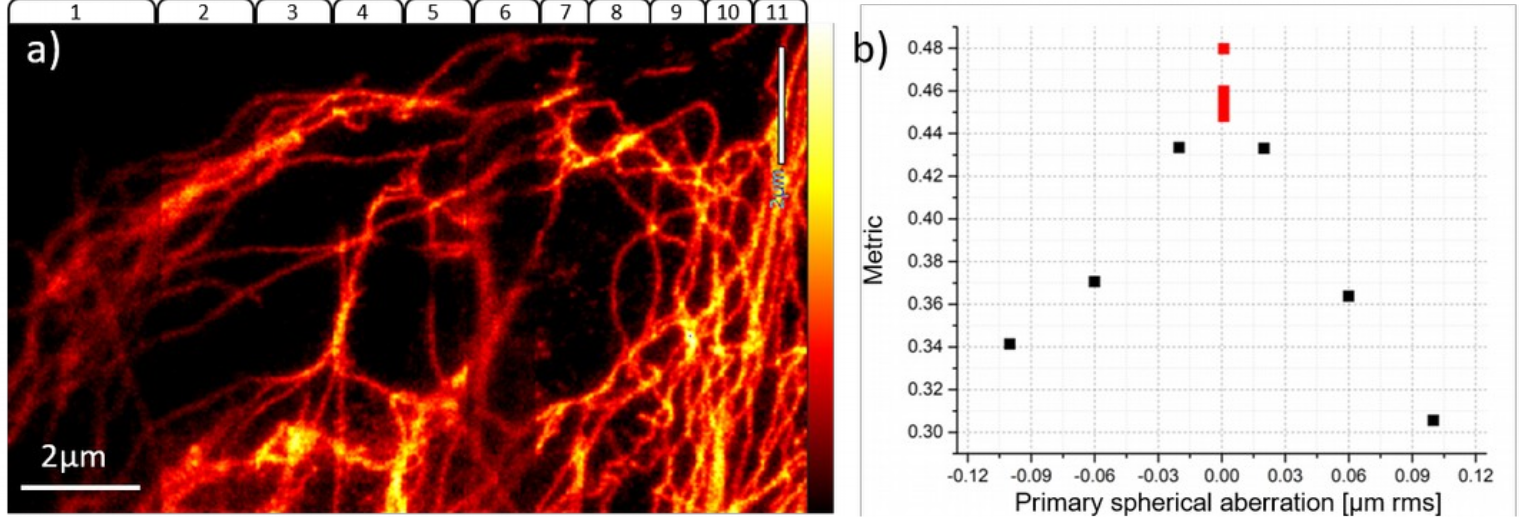
Fast and sample-friendly aberration correction for STED microscopy
A simple metric, based on local changes in the fluorescence lifetime was found to reflect the quality of the STED focus. This metric can be used to correct abberations fast, on-line and continuously over the whole image, using a simple deformable mirror and an elaborated algorythm.
Challenge
Sample-induced aberrations pose a challenge for high-resolution fluorescence microscopy, since they significantly impair the image quality. Their compensation can be performed with adaptive optics (AO). However, this requires either direct measurement of the wavefront or, preferably, the detected fluorescence signal itself must be analyzed. Up to now, image properties such as brightness and sharpness have been used for this purpose, which requires repeated image recordings and ananlysis. This slows down imaging and promotes photobleaching, which can lead not only to errors but will also to greatly reduced image brightness and thus its quality.
Our Solution
Instead of using a metric which analysis an image for adaptive optics based aberration correction, the inventors analyze the fluorescence photon stream itself and hereby exploit the fact that the fluorescence lifetime depends on the local STED intensity. This photon stream-based metric is independent of sample properties like structure and brightness and can be performed in principle on a single pixel. An on the flight abberation correction at each location be realized without the increasing the light dose or the image acquisition time. A simple state of the art deformable mirror and a software update will significantly improve image quality of biological samples.
 Figure 1: Live and automatic aberration correction while imaging vimentin filaments. During STED image acquisition, the image quality is optimized stepwise (a). Each iteration step can be performed after a few pixels. In (a) the steps are elongated to visualize the image improvement. The corresponding metric values show a maximum for optimal aberration strength (b).
Figure 1: Live and automatic aberration correction while imaging vimentin filaments. During STED image acquisition, the image quality is optimized stepwise (a). Each iteration step can be performed after a few pixels. In (a) the steps are elongated to visualize the image improvement. The corresponding metric values show a maximum for optimal aberration strength (b).
This technology is especially useful for STED-microscopy, of deep and inhomogeneous samples and can extend the working depth of objective lenses in refractive-index mismatched samples.
Advantages
- Fast and instant aberration correction at each location in the sample
- Correction is Independent from sample structure and brightness
- No additional light has to be applied to the sample
- Simple and cheap implementation via software update and a single deformable mirror
- The metric can be used in any appplication, where two laser beams are overlapping and one beam induces local differences in the lifetime of the excited fluorophoresistenpunkt 2
Development Status
The inventors have successfully detected and compensated different kinds of aberrations in technical and simple biological samples. Currently, they extend the method to relevant biomedical samples and validate its robust and simple applicability.
Patent Status
We have pending German and international PCT patent applications and can offer worldwide protection rights
Contact
Dr.Martin Andresen
Patent Manager Life Sciences
E-Mail: This email address is being protected from spambots. You need JavaScript enabled to view it.
Tel.: +49 551 30724 150
Reference: CPA-2102-LLG
Tags: fluorescence, FLIM, lifetime, Nanoscopy, microscopy, Abberation, STED
